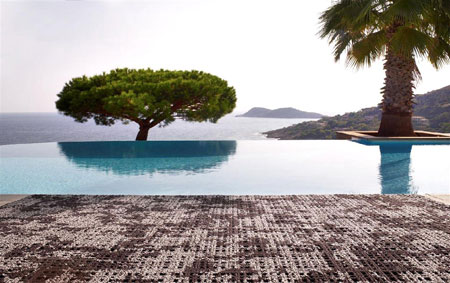Flying carpet
Updated: 2012-07-09 14:56
By Rebecca Lo (China Daily)
|
|||||||||||
 |
|
Top and below: Tai Ping outdoor collections. Middle: Tai Ping's best employees tend to be women, who are both good at selling the products and great at the detailed handiwork. Above: Hong Kong designer Andre Fu. Photos Provided to China Daily |


Hong Kong-based Tai Ping Carpets revives the lost art of hand woven silk carpets deep in the heart of Foshan. Rebecca Lo tries to keep her finger steady upon the weaving gun's trigger.
I have a closely guarded secret: I'm lousy at anything that has to do with hand-to-eye coordination. I still hang my head in shame thinking of all those humiliating years when I was the last person to be chosen for any baseball team. And driving? I hit another car during my road test. That's why I take the bus.
When Tai Ping Carpets' head of hand weaving in its Foshan factory handed me a yarn gun and said that it was easy, I thought to myself: Ha!
She directed me to a giant white canvas backing and I watched as she made the process of steadily shooting a series of stitches into the fabric look as simple as breathing.
Then it was my turn. After noticing a first aid kit conveniently close by, I took aim and did my best. I managed to weave stitches that were more or less straight and relatively even. Though the head of hand weaving huffed and said that I could have done better, I was happy that I survived unscathed.
More importantly, I fully appreciated the technique and dedication involved in every carpet handmade by Tai Ping's team.
Tai Ping Carpets has come a long way since a 1956 dinner table chat between Sir Lawrence Kadoorie and his six friends who wanted to revive the art of weaving silk carpets in China.
At the time, Hong Kong was seeing a steady stream of immigrants from Chinese mainland, and many were unskilled laborers who left their farms seeking better lives in the British colony.
Kadoorie, whose family businesses included The Peninsula Hotel and China Light & Power, believed that they possessed the determination to embark upon entirely new careers, regardless of age and education.
Tai Ping Carpets was born initially as a philanthropic endeavor to employ these workers, but the meticulously crafted custom silk and wool carpets quickly became hot items on the international market.
Tai Ping's best employees tend to be women - and that remains true today. Women are both good at selling the products and great at the detailed handiwork involved in making them.
Many of the departments in Tai Ping's Foshan factory are headed by female supervisors.
At the first stage of the wool carpet making process, the fluffy stuff from New Zealand or Thailand is cleaned, sorted and mixed depending on the order.
Then the material goes through a carding process that is entirely mechanized, eventually ending up on large spools. At this point, the wool is either spun into single- or multiple-ply yarns.
Color is really where Tai Ping excels. Walking into the dye lab is like returning to high school chemistry class.
Sporting white lab coats, scientists carefully eye drop pure hues from Erlenmeyer flasks into color spectrometers to match exact shades for the perfect carpet.
All of Tai Ping's dyes come in powder form and are from England. Each color is dissected down to a formula combining different weights of primary, secondary and tertiary hues.
Three sizes of vats are available for dyeing different quantities of yarn to ensure that the same color is consistent for an entire carpet, regardless of whether it is 1 or 100 meters long.
While Tai Ping contains 22 Axminster weaving machines that can produce custom carpets between 3 and 5 meters wide, its hand weaving building is the hub of the factory.
"There are some carpets that cannot be woven by the Axminster machines," explains Billie Wong, Tai Ping's business development manager. "The 100 percent silk carpets have to be woven by hand."
Axminster patterns are programmed into each machine before weaving begins, while hand-woven patterns have to be scaled by designers into the desired size before they are transferred onto a plastic sheet.
The pattern is punched into the sheet with a series of fine holes, and then washed onto a backing with a light layer of ink. Each backing is hung vertically and weavers each get a palette of poms, or small yarn samples, and a color print out of the overall pattern they are creating. Then they get to work.
The number of hours invested into each carpet depends on how easily the yarns handle, the complexity of the pattern, the number of different materials in the carpet and the number of stitches required per square inch - and that all affects the overall price.
For Hong Kong designer Andre Fu's collection, the level of craftsmanship is very high since his carpets use a combination of silk with other materials and both tuft and loop pile. Fu says it best when referring to his design for Tai Ping: "It's a reinvention of the long-established artisanship of Tai Ping's heritage - a modern collection that is calming and sophisticated, yet highly emotional and sensuous." Much like every aspect of Tai Ping Carpets itself.
Tai Ping prefers to have one weaver work on each carpet, as the person's handiwork is evident in subtle ways such as how tight the stitches are woven.
Afterwards, the carpets get a layer of adhesive to fix the yarns to the backing, edges are finished and piles are trimmed before they get shipped around the world.
Tai Ping carpets are popular choices in hotels and restaurants because they are customized according demands.
You can even find them in Windsor Castle. Tai Ping presented one each to Prince Charles and the late Princess Diana as well as Prince Edward and Sarah Ferguson on the occasion of their marriages.
Tai Ping recently moved its corporate head office from Taikoo Shing to Kwai Hing's Kowloon Commerce Center.
Designed by both the Hong Kong and New York City offices of M Moser Associates, it features Tai Ping's various carpet brands integrated into different areas such as reception, sales and meeting rooms, and back office.
The office "feels like Parisian luxury and is well designed and comfortable while being aspiring and inspiring, which is the very feeling of Tai Ping rugs," says New York City-based Simone Rothman, Tai Ping's chief marketing officer.
Related Stories
Models shine at New Silk Road Model Contest 2012-06-21 14:21
Silk Road-era folk customs revisited 2012-06-07 14:20
Silky smooth 2012-04-06 14:06
Today's Top News
Rescuers race against time for quake victims
Telecom workers restore links
Coal mine blast kills 18 in Jilin
Intl scholarship puts China on the map
More bird flu patients discharged
Gold loses sheen, but still a safe bet
US 'turns blind eye to human rights'
Telecom workers restore links
Hot Topics
Lunar probe , China growth forecasts, Emission rules get tougher, China seen through 'colored lens', International board,
Editor's Picks

|

|

|

|

|

|





